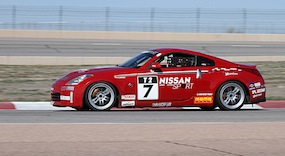Testimonials
Essential for Production Race Cars
Keeps my caliper seals from cooking.

I remember the days in the 80s and 90s, when one of the key skills in driving a production race car was keeping from bending your brake pad backers. ...
Read More ->
Keeps my caliper seals from cooking.

The Brembo brakes on my Nissan Sport-sponsored 350Z T2 racecar are a huge strength. Using Hoosier R-compounds generates additional heat over the...
Read More ->
Specials

DPF7876 Titanium Brake Shim for Alcon, Mitsubishi EVO FQ
$97.99
Sale: $68.59
Special: 30% off
Sale: $68.59
Special: 30% off
Track Wisdom
Where does the shielded brake heat go?
Not all of the heat shielded by our heat shields is reflected straight back into the pads, some of it is dispersed radially, away from the caliper/pad contact zone. Heat travels from hot to cold areas, so since the pad is the source of the heat most of the time, very little heat will transfer from the cooler shield into the hotter pad. That said, some folks do tend to run higher temp brake pads with our shields, but that is a normal decision that racers are making all the time, matching pad compounds to track and racing conditions.











